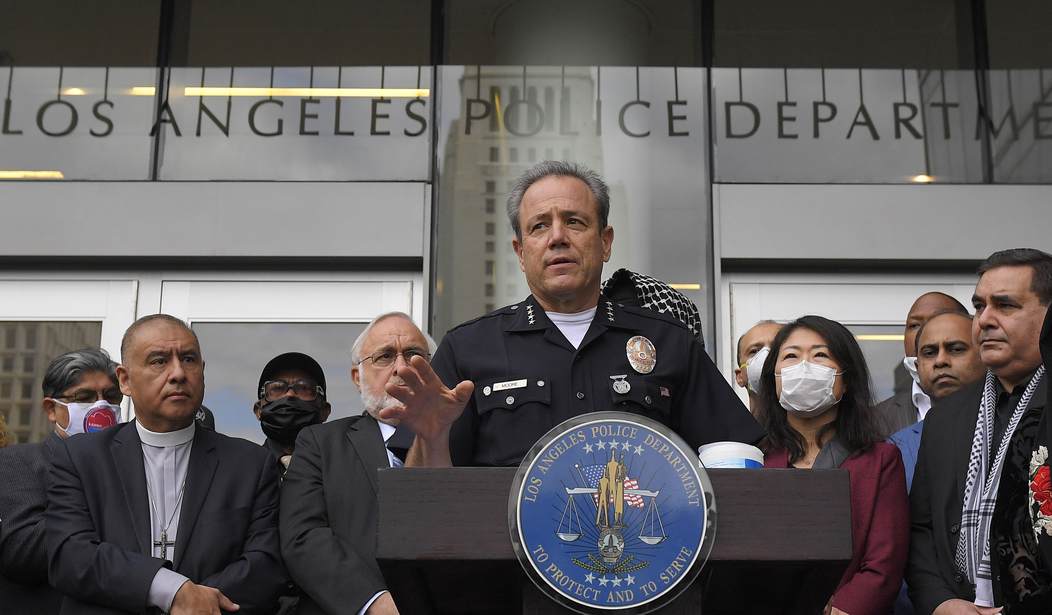Any government whose law enforcement apparatus is immune from scrutiny by a free press is all but guaranteed to become oppressive, and it goes without saying that we, as free Americans, would bridle at any such arrangement. But there is a danger in the other direction as well, one in which police leaders are so concerned with how they are portrayed in the media that they lose sight of their mission to reduce crime. Such is the current state of the Los Angeles Police Department, whose chief Michel Moore lives in fear of what might be written about him in the Los Angeles Times.
On May 3, in downtown Los Angeles, 54-year-old Leron James allegedly brandished a handgun at firefighters, who then notified the LAPD. Patrol officers responded but could not coax James from his 5th-floor apartment, prompting a response from the LAPD’s SWAT team. When James opened fire from his apartment window, two SWAT officers returned fire and killed him. So here we have a straightforward set of facts and a use of deadly force by the police about which there should be little controversy.
Alas . . .
According to a May 20 story in the L.A. Times, as SWAT officers were preparing to deploy on the incident, one of them was captured on another’s body-worn camera saying, “Happy hunting.” Neither the officer who made the comment nor the one he said it to were involved in shooting James, and as hot-microphone indiscretions go, this one strikes me as pretty mild. That didn’t prevent someone from bringing it to the attention of the L.A. Times, whose writers and editors exult in any opportunity to present the police, especially the LAPD, in an unfavorable light.
Responding to the Times’s story like an obedient servant was LAPD chief Michel Moore, who said the offending officer had been removed from field duty pending the outcome of an investigation. “It’s a disturbing remark,” Moore said. “Gallows humor or otherwise, it doesn’t have a place.”
Oh, please. Having worked some time ago at the same division and same rank as Moore, I can attest that he regularly made comments far, far more “disturbing” than this one. He can be grateful (as can I) he did his time on the streets in the days before body-worn cameras, when mildly inappropriate remarks like this one resulted in nothing more than a talking-to from a sergeant out by the gas pumps. Those days are long over, and yes, this and every officer should be circumspect in what he allows to be recorded for posterity, but the reaction to this has been beyond absurd.
Moore promises an “investigation” into the matter. Of what, exactly? The remark was caught on video, so the only questions to be asked are what policy was violated, if any, and if there was a violation, what to do about it. No matter how quickly and easily these questions can be answered, the unfortunate officer will probably spend up to a year on administrative duties as Moore and his top brass twiddle their thumbs in their typical fashion and the internal affairs process drags on. In the meantime, the officer’s life will be upended, and the LAPD and the citizens of Los Angeles will be needlessly denied the benefits of his skills and expertise.
Not content with giving the shaft to a single officer, Moore has ordered a review of SWAT operations over the last ten years in an effort to uncover “any potential problems or patterns” that might have gone unnoticed in what is already the most scrutinized entity in the LAPD. I expect the L.A. Times to soon report on an officer being reprimanded for parking the SWAT truck in a handicap zone during a barricaded-suspect operation.
What will not be investigated, unfortunately, is the question of who brought the “happy hunting” matter to the attention of the L.A. Times. Who is it within the organization who stands to benefit from the upheaval that will follow? The Times was quick to link this incident to its 2020 reporting on a pending lawsuit filed by a former SWAT supervisor who alleged the existence of a “SWAT mafia” whose members encourage the use of deadly force. In August 2020 I commented on that lawsuit here on PJ Media, offering statistics that would seem to belie the plaintiff’s allegations. The L.A. Times clearly has a source close to the matter, yet these relevant statistics are never included in any of the paper’s coverage on this issue.
Related: More Dishonesty in the LA Times About the LAPD
So, since the L.A. Times can’t be bothered to ask for these numbers, or else has them but won’t print them for the corrosive effect they may have on the paper’s long-propagated narrative, I present them here. The LAPD began capturing detailed statistics on SWAT deployments in 2013, since which time the team has responded to more than 1,200 incidents. And bear in mind they respond only to incidents in which suspects are armed or believed to be, to include call-outs for barricaded suspects and warrant service for high-risk circumstances. In all of these deployments, force of any type, ranging from deadly force to tear gas to even the least aggressive forms of physical restraint, was used in just 8 percent of them. Deadly force was used in a mere 1.4 percent of the deployments.
If there is a “SWAT mafia,” they don’t seem to have much influence on these outcomes, a fact you won’t find in the pages of the Los Angeles Times.










Join the conversation as a VIP Member